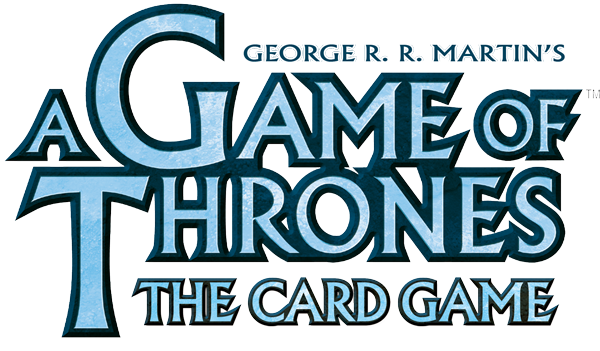
Plotting and Scheming, Part One
A Look at Mastering Your Plot Deck in A Game of Thrones: The Card Game

“He moved his own men into place. The Keepers of the Keys were his, all four. The King’s Counter and the King of Scales were men he named. The officers in charge of all three mints. Harbormasters, tax farmers, custom sergeants, wool factors, toll collectors, pursers, wine factors; nine of every ten belonged to Littlefinger.”
–George R.R. Martin, A Clash of Kings
In A Game of Thrones: The Card Game, the Great Houses are at each other’s throats. They spy on each other and hatch malicious intrigues. They rally armies against each other. They spill blood on the battlefield. They lie, they kidnap, and they kill. Personal rivalries spark wars, and more than a few men have died who once aspired to sit the Iron Throne.
To seize control of the Seven Kingdoms, then, you need to be more than a little clever, and you need to be well aware of how the game is played. Accordingly, our exploration of A Game of Thrones: The Card Game begins with a brief review of the different reasons it holds a unique place among customizable card games:
- It allows players to immerse themselves in George R.R. Martin’s fictional world of Westeros by visiting its most renowned locations and calling upon the services of such iconic characters as Robb Stark, Jaime Lannister, Daenerys Targaryen, Littlefinger, and many more.
- With its over-the-table politics and treachery, the game’s melee (multi-player) format is every bit as dynamic, structured, and competitive as its joust (head-to-head) format. Moreover, the game’s largest tournaments challenge players to master both formats in order to claim the overall title.
- With three distinct types of challenges that represent the military battles, political intrigues, and power struggles that write the history of the Seven Kingdoms, A Game of Thrones: The Card Game plays on multiple levels simultaneously. If you fail to balance your military strengths against your weaknesses in intrigue and power struggles, you can win every battle and still lose the war.
And, finally, the point that lies at the center of today’s focus: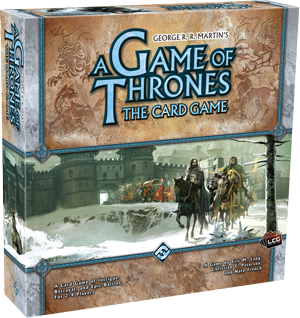
- In addition to their draw decks, players bring seven-card plot decks to every game. While your draw deck is randomized, as in nearly every other card game in the history of customizable card games, your plot deck provides you the opportunity each game round to make a critical decision with far-reaching ramifications. You want to win the Iron Throne? You need to learn how to manage your plots.
While each of the above items helps define the unique experience of A Game of Thrones: The Card Game, the addition of the plot deck is arguably the point that veteran card gamers will find that most distinguishes it from other games. This also means that finding success in A Game of Thrones: The Card Game is largely a matter of mastering the art of building your plot deck and revealing your plots one by one.
The Importance of Your Plot Deck
While characters like Eddard Stark (Core Set, 5), Robert Baratheon (The Tower of the Hand, 46), and Cersei Lannister (Lions of the Rock, 6) may be some of the cards players will most readily identify with the epic fantasy saga that inspires A Game of Thrones: The Card Game, plots like Summoning Season (Core Set, 181), Wildfire Assault (Core Set, 191), and Valar Morghulis (Core Set, 201) should be some of the cards you associate most closely with how the game is played.
Plots are powerful. They stand among the game’s most reliable cards. Instead of drawing into your plots at random, as you do with the cards from your draw deck, you reveal one plot of your choice at the beginning of each game round. The plots that you and your opponent reveal establish the whole tone of the round.
Each plot carries four key pieces of information, which are called out below on the Core Set plot, Wildfire Assault:
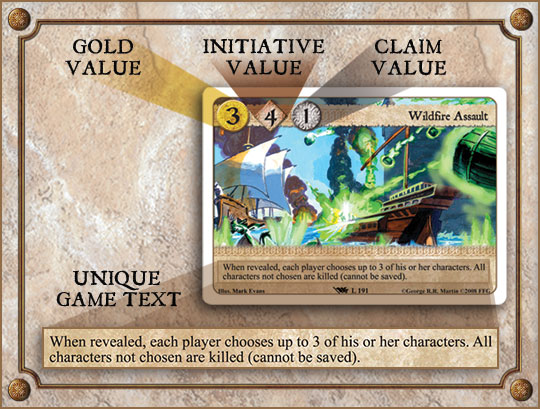
- Gold value. This is how much gold your plot provides you at the beginning of your marshaling phase. This number can be modified upward or downward by other cards in play, but a larger gold value is generally better than a smaller one.
- Claim value. This is the size of your “claim.” Whenever you win a challenge as the attacker, the loser must satisfy that challenge’s claim. If you win a military challenge as the attacker, your claim value is the number of characters your opponent must kill. If you win an intrigue challenge as the attacker, this is the number of cards your opponent must discard at random. If you win a power challenge as the attacker, this is the amount of power that you may steal from the loser’s House card to place upon your own.
- Initiative value. This number determines which player wins initiative and can decide the order in which players will go through the game’s different phases in the round. You don’t always want to go first, but it’s usually better to decide when you want to go than to have your opponent make the decision.
- Unique game text. Plots can make some truly remarkable impacts upon the game, many of which affect the board, universally. As an example, Valar Morghulis kills every character in play. Similarly, Fear of Winter (Beyond the Wall, 40) prevents each player from playing, or putting into play, more than one card in the round it is revealed, and The Power of Blood (Core Set, 194) simply states that noble-crested characters cannot be killed. In fact, the vast array of effects that plot cards can introduce to the game ought to be one of your first considerations as you build not only your plot deck, but your draw deck, as well.
Precisely how powerful are plots? One indication may come from a review of the game’s current restricted list, identified in the latest FAQ (pdf, 2.2 MB) and tournament rules (pdf, 1.4 MB). There are six types of cards you can factor into deck-building for A Game of Thrones: The Card Game – agendas, characters, locations, attachments, events, and plots. Of the thirty-eight cards currently restricted for the game’s joust format, thirteen are plot cards, roughly double their representation among the available card types.
Because you not only can, but must, reveal a new plot at the beginning of each round, it’s not far-fetched to consider your plot deck the most important seven cards that you bring to a match of A Game of Thrones.
Building a Plot Deck
After you come to understand the importance of your plot deck, how do you go about building one? There are, of course, multiple methods, and they tend to vary according to your style.
Aggressive: Aggressive players should pay very close attention to the initiative and claim values of their plots. Here, plots like Take Them by Surprise (Lords of Winter, 52) and Seizing the Prize (Spoils of War, 19) can help you gain momentary tactical supremacy. While it’s not always as simple as it sounds, the best way to ensure that your opponent doesn’t make many successful challenges against you is by racing to the challenges phase first and killing off his characters or emptying his hand before he can retaliate. Even though there are times when an aggressive player may want to go second – say, if he’s facing a Lannister deck with many targeted kneeling effects – you will need to win the initiative in order to choose when you go. Then, if you can establish an early lead, plots like Blockade (Core Set, 193) and Fear of Winter can help you maintain your pressure and momentum.
A sample plot deck for an aggressive Greyjoy player might contain: Blockade, Fear of Winter, Rise of the Kraken (Kings of the Sea, 54), Seizing the Prize, Take Them by Surprise, The King’s Law (Kings of the Storm, 49), and Valar Morghulis.
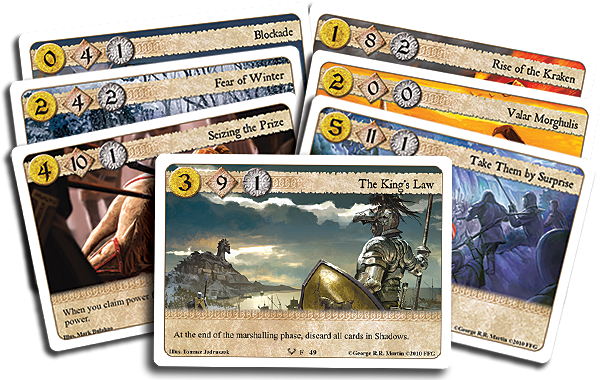
Control: Players who prefer to build their forces slowly while limiting the effectiveness of their opponents’ actions will want to focus on plot decks that build in strength as the game carries forward. Control players would do well to explore the options presented to them by the game’s City and River plots, both of which derive additional power from the City or River plots already in your used plot pile. Moreover, you’ll want to include key reset plots. Valar Morghulis is arguably the best reset plot in the game; it’s certainly the most common. Still, plots like Wildfire Assault and The First Snow of Winter (On Dangerous Grounds, 59) can also serve as powerful resets when accompanied by certain deck types. Finally, there’s another set of plots that simply fit into a control player’s overall style by limiting your opponent’s options. The Art of Seduction (Lions of the Rock, 52) has recently become a highly popular plot for its ability to prevent your opponent from revealing a new plot against you in the subsequent round, and Fortified Position (Lords of Winter, 50) can shut off nearly every troublesome character ability in the game.
A sample plot deck for a control-oriented Martell player might contain: A City Besieged (Chasing Dragons, 59), At the Gates (Gates of the Citadel, 20), City of Lies (City of Secrets, 19), City of Sin (A Time of Trials, 40), City of Soldiers (The Battle of Blackwater Bay, 120), City of Spiders (Tales from the Red Keep, 80), and Wildfire Assault.
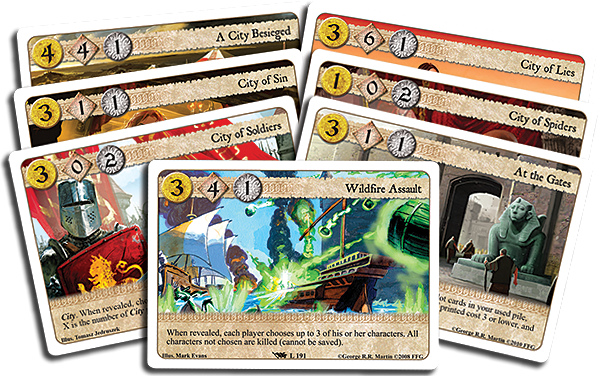
Combo: There are a host of intricate and powerful card combos available in A Game of Thrones: The Card Game, and players who want to build decks around pulling these disparate pieces together would do well to explore the power of plots that trigger search effects or safeguard different pieces of their combos. Summoning Season is a boon to any player looking to build a deck around a key character; presumably, if you need to dig for a copy of a character that’s central to your strategy, it’s worth offering your opponent access to a character of his choice, as well. Likewise, Building Season (Core Set, 195) can help you fetch a key location, and plots like Counting Favors (Core Set, 203) simply let you draw more of the cards in your deck, getting ever closer to your combo. Notably, all three of these example plots serve as examples of another type of plot, “bargaining” plots, which we’ll explore below.
A player looking to build a powerful card combination from House Targaryen might consider a plot deck containing Building Season, Counting Favors, Spending the Winter Stores (Queen of Dragons, 52), Summoned by the Conclave (A Hidden Agenda, 120), The First Snow of Winter, Valar Morghulis, and Wildfire Assault.
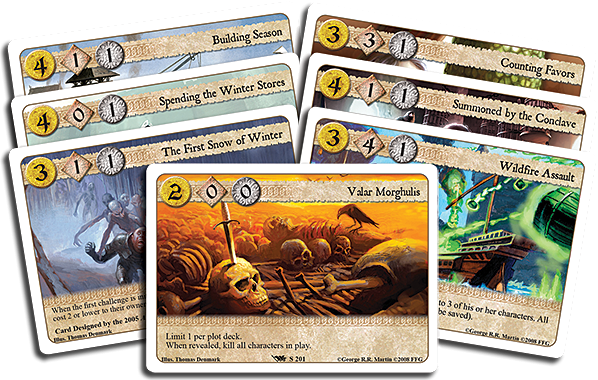
Melee: In melee, it’s difficult to win a game strictly based upon the strength of your deck and the characters you put into play. Accordingly, your goal is typically to get within striking distance of victory without anyone recognizing the threat you truly pose. One of the best ways to deflect some of the early pressure in a melee game is to use plots like Summoning Season, Building Season, and Counting Favors as bargaining chips. Will you ask to be the first player? The last player? Will you ask for an opponent to target someone else, instead of you for one turn? To add weight to your request, you need to offer something in return, and these bargaining plots are fantastic tools in melee games.
There are easily as many types of melee decks that a player can create as there are joust decks. Accordingly, no sample of seven plot cards would well represent the array of potential melee decks. Nonetheless, some of the game’s best bargaining plots include Building Season, Counting Favors, Negotiations at the Great Sept (The Pirates of Lys, 59), and Summoning Season.
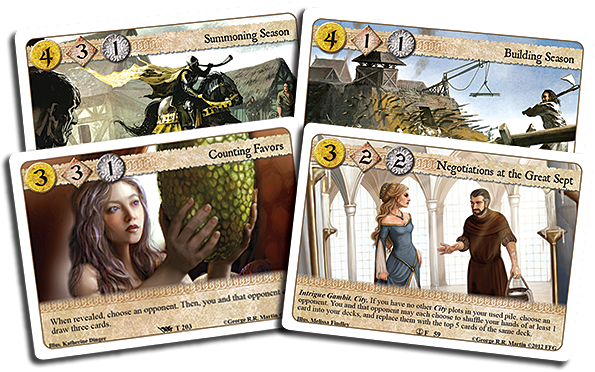
Toolbox: Sometimes, you just want a collection of powerful abilities that you can reveal whenever they seem useful. This “toolbox” approach is the one most often employed by new players, and while it doesn’t always work in those cases, it’s an approach that can be refined as you learn how to balance your concerns for gold, claim, and initiative values against the abilities that might be useful to bring into play. Such a plot deck will usually feature at least one reset plot, at least one high gold plot, at least one high initiative plot, and at least one plot with some control value. If it doesn’t feature a plot that directly limits your opponent’s actions, it may feature a plot like Outwit (The Isle of Ravens, 80), which allows you to kneel a learned-crested character to cancel the harmful “when revealed” effect from an opponent’s plot. Other additions to a toolbox plot deck may apply greater pressure to an opponent during the challenges phase, like Frey Hospitality (Lions of the Rock, 49), or allow you to grab early power, like Into the Lists (Tourney for the Hand, 20).
A sample Stark plot deck built around the “toolbox” approach might contain plots like Outwit, Retaliation! (A Song of Silence, 80), Summoning Season, The First Snow of Winter, The Minstrel’s Muse (Return of the Others, 120), Winter Festival (Wolves of the North, 20), and Valar Morghulis.
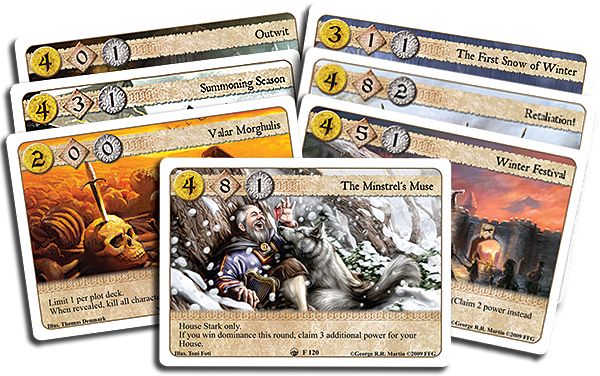
Plotting Victory
While you’re building your plot deck, you should always aim to include plots that will benefit you more than they’ll benefit your opponents, so you need to keep the composition of your deck in mind. There are enough considerations and interactions between the composition of both decks to merit an entire article, but as an example, you wouldn’t want to include Building Season in a deck where your most impactful location is Street of Silk (Lions of the Rock, 40). Even though Street of Silk offers a tremendous economic advantage if you have unique characters to play each turn, it’s not going to offset the damage you’d do to yourself by allowing your opponent to fetch Ghaston Grey (Forging the Chain, 34) or The Iron Throne (Lions of the Rock, 31).
Even once you’ve built and refined your plot deck, you’ve only mastered half the art of plotting successfully in A Game of Thrones: The Card Game. You still need to learn the art of revealing your plots. After all, the game of thrones is filled with bluffs, deceptions, counter-bluffs, ruses, and treacheries. One false move can spell disaster. One triumphant move can clear your path to the Iron Throne.
In our next installments of Plotting and Scheming, we’ll look at the interactions between your plot deck and your draw deck, we’ll explore the impact of “plot twists,” and then we’ll turn to the art of revealing plots, as well as sample plot reveals for both an aggressive Stark deck and a Lannister control strategy.
…
